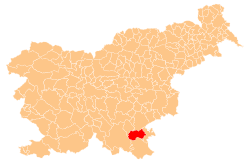Lahinja, Semič
Lahinja (pronounced [ˈlaːxinja]; also Lahinja pri Sredgori,[1][2] in older sources Lahina;[3] German: Lachina[4] or Lachina bei Mittenwald;[5] Gottscheerish: Lachinə[6]:88) is a remote abandoned settlement in the Municipality of Semič in southern Slovenia. The area is part of the traditional region of Lower Carniola and is now included in the Southeast Slovenia Statistical Region.[7] Its territory is now part of the village of Planina.
Lahinja | |
|---|---|
 Lahinja Location in Slovenia | |
| Coordinates: 45°36′58.50″N 15°6′51.30″E | |
| Country | |
| Traditional region | Lower Carniola |
| Statistical region | Southeast Slovenia |
| Municipality | Semič |
| Elevation | 647.6 m (2,124.7 ft) |
| Population (2002) | |
| • Total | none |
Name
The name Lahinja is shared with the Lahinja River. If the names share the same origin, then it is derived from *Vlahinja, based on the root *Vlah and originally referring to pre-Slavic Romanized Celtic inhabitants of the area[8] but also applied to later Uskok settlers in the region.[6]:88 Another theory derives the name of the village from Middle High German lâchen 'to mark trees with a blaze'.[9] In the past the German name was Lachina.[5]
History
Lahinja was a Gottschee German village. In the land registry of 1574 the village had three full farms divided into six half-farms with seven owners, corresponding to a population between 25 and 30.[9] The village attained its maximum population in 1880, with 56 people living in nine houses. It had five houses and a population of only 32 in 1931.[6]:88 At this time, the economy of the village was based on raising animals, tending vineyards at Rodine, and selling firewood, logs, and wooden goods.[1] The original inhabitants were evicted from the village on 24 November 1941.[6]:89 It was burned by Italian troops in the summer of 1942 during the Rog Offensive and was never rebuilt.[2]
References
- Krajevni leksikon Dravske Banovine. 1937. Ljubljana: Zveza za tujski promet za Slovenijo, p. 124.
- Savnik, Roman, ed. 1971. Krajevni leksikon Slovenije, vol. 2. Ljubljana: Državna založba Slovenije, p. 43.
- Intelligenzblatt zur Laibacher Zeitung, no. 141. 24 November 1849, p. 48.
- Ferenc, Mitja. 2007. Nekdanji nemški jezikovni otok na kočevskem. Kočevje: Pokrajinski muzej, p. 4.
- Leksikon občin kraljestev in dežel zastopanih v državnem zboru, vol. 6: Kranjsko. 1906. Vienna: C. Kr. Dvorna in Državna Tiskarna, p. 6.
- Ferenc, Mitja, & Gojko Zupan. 2012. Izgubljene kočevske vasi, vol. 2 (K–P). Ljubljana: Znanstvena založba Filozofske fakultete Univerze v Ljubljani.
- Semič municipal site
- Snoj, Marko (2009). Etimološki slovar slovenskih zemljepisnih imen. Ljubljana: Modrijan. p. 224.
- Petschauer, Erich. 1980. "Die Gottscheer Siedlungen – Ortsnamenverzeichnis." In Das Jahrhundertbuch der Gottscheer (pp. 181–197). Klagenfurt: Leustik.
